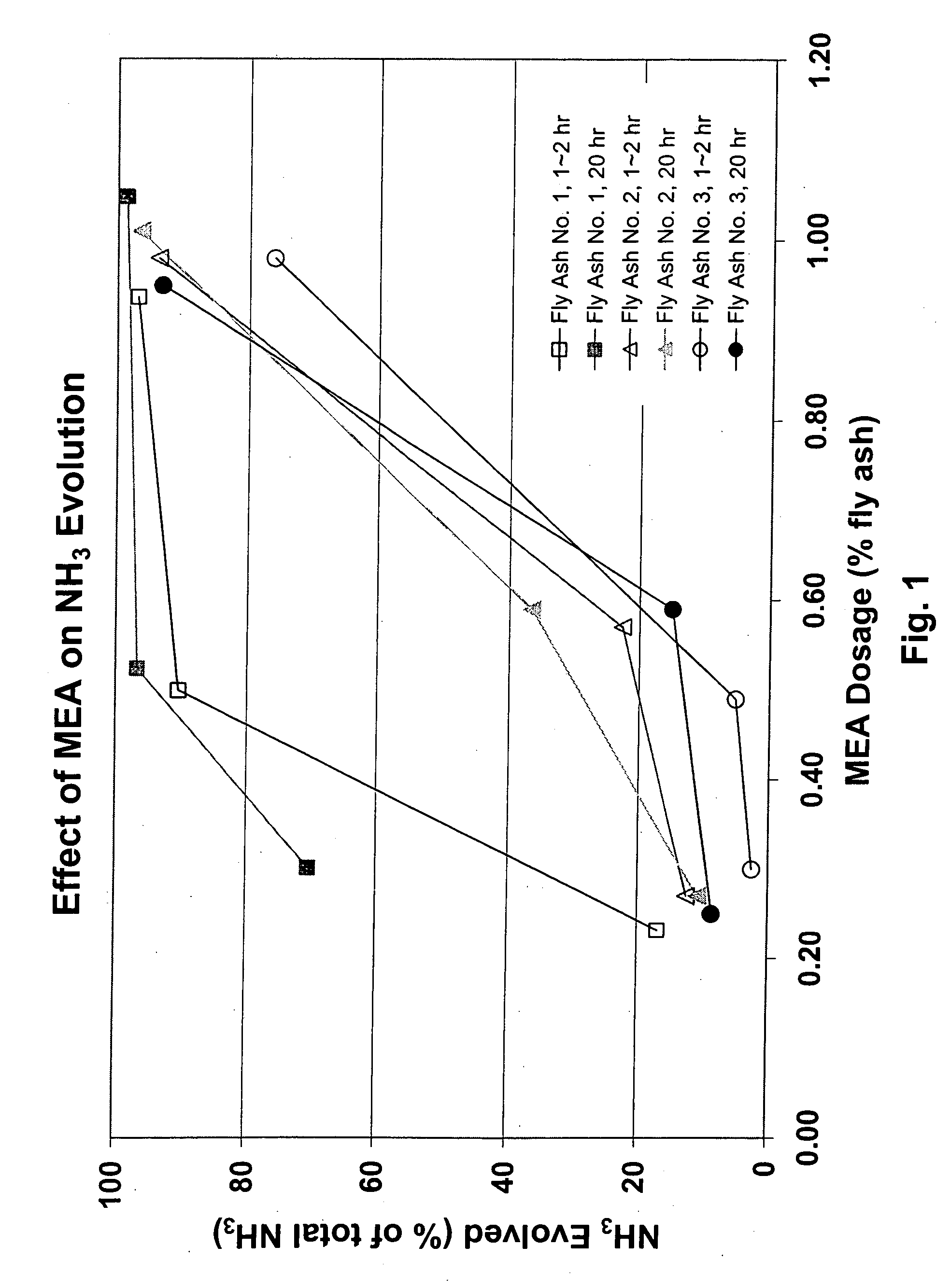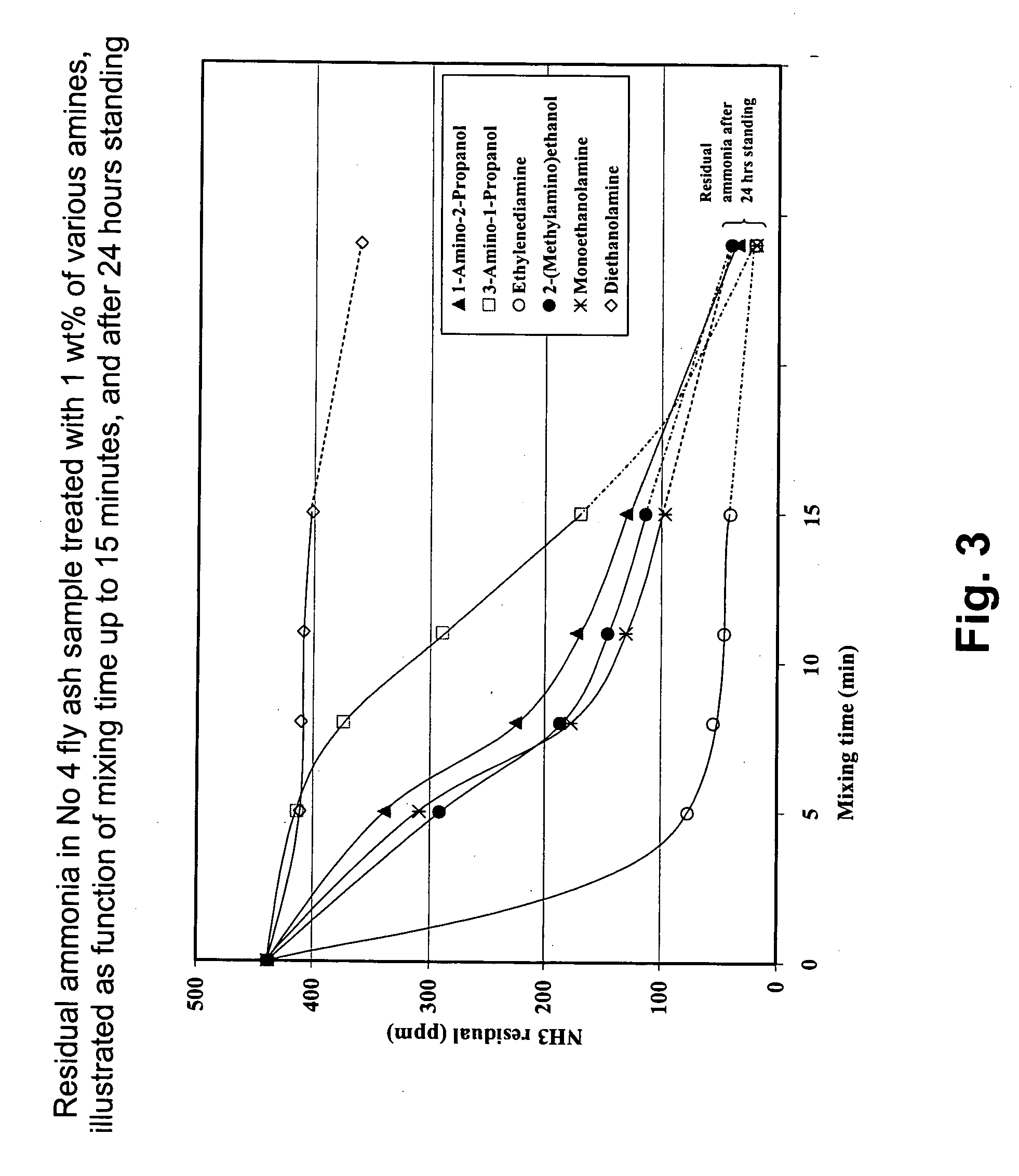Method of removing ammonia from fly ash and fly ash composition produced thereby
a technology of fly ash and ammonia removal, which is applied in the direction of solid waste management, sustainable waste treatment, separation processes, etc., can solve the problems of ammonia presence, ammonia containing ammonia, and ammonia in fly ash itself, so as to reduce the ammonia content of ammonia-laden fly ash
- Summary
- Abstract
- Description
- Claims
- Application Information
AI Technical Summary
Benefits of technology
Problems solved by technology
Method used
Image
Examples
example 1
Treatment of Ammonia-Laden Fly Ash with Monoethanol Amine
[0044] Fly ash (FA) samples were collected from three coal burning plants. These samples are generally representative of fly ash available from various coal burning plants across the U.S. Each of the three samples was mixed in an aqueous slurry with 1% by mass fly ash and tested to determine the pH and initial ammonia content of the samples. As indicated in Table 2 below, sample 1 had an initial pH of 11.6 and ammonia content of about 256 ppm, sample 2 had an initial pH of 12.4 and ammonia content of about 489 ppm, and sample 3 had an initial pH of 4.3 and ammonia content of about 66 ppm.
[0045] Each of the samples was divided into 6 subsamples. Each subsample was treated with a treating composition containing monoethanol amine (MEA) in the amounts shown in the table and treated for the elapsed time as indicated in the table. For each sample, the first four of the 6 subsamples were treated between 1 and 2 hours, and the remai...
example 2
Effect of Dilution of MEA
[0047] As shown in Table 2 and reflected in the graph of FIG. 2, two untreated portions were selected from each of the three samples. For each sample, the first of the two portions was treated with a wt % of MEA and the second portion was treated with a like amount of MEA in addition to an equal amount of water. The effectiveness of the alchol amine is shown to be unchanged by the dilution with water in one sample and to substantially improve the effectiveness in two other samples. This shows that a minimal amount of water may be used to effectively disperse the base and provide increased contact with the fly ash. The moisture content is controlled so as not to require supplemental drying after treatment.
TABLE 2WaterMEAContentContentElapsedresidual[NH3]Sample(wt %(wt %Time[NH3]Evolved% NH3IDof FA)of FA)(hrs)Agitation(ppm in FA)(ppm in FA)Evolved10.00.521˜2stirred every 15 min.24.6232.290.410.500.501˜2stirred every 15 min.33.7223.186.920.00.571˜2stirred ev...
example 3
Treatment with Various Organic Bases
[0049] Two fly ash bulk samples were collected to test different alternative organic bases; the first, designated Sample No. 4, had a pH of 12.2 (in 10 wt % aqueous slurry) and contained 430 ppm ammonia; the second, designated Sample No 5, had a slurry pH of 10.4 and an ammonia content of 292 ppm. From these bulk samples, 300-gram subsamples were taken and treated with various organic bases at 1.0 wt % dosages, in the absence of water; these organic bases include: [0050] Monoethanolamine, [0051] Diethanolamine, [0052] Ethylenediamine, [0053] 3-Amino-1-Propanol, [0054] 1-Amino-2-Propanol, and [0055] 2-(Methylamino)-Ethanol
[0056] A 300-gram fly ash subsample was placed in a Hobart-type mixer and, while stirring the fly ash material, the liquid organic base was injected slowly onto the solids over a period of 30 seconds; 50-gram portions of the treated fly ash were removed at 5, 8, 11 and 15 minutes for residual ammonia analysis. Mixing was stopped...
PUM
| Property | Measurement | Unit |
|---|---|---|
| temperatures | aaaaa | aaaaa |
| wt % | aaaaa | aaaaa |
| pH | aaaaa | aaaaa |
Abstract
Description
Claims
Application Information
 Login to View More
Login to View More - R&D
- Intellectual Property
- Life Sciences
- Materials
- Tech Scout
- Unparalleled Data Quality
- Higher Quality Content
- 60% Fewer Hallucinations
Browse by: Latest US Patents, China's latest patents, Technical Efficacy Thesaurus, Application Domain, Technology Topic, Popular Technical Reports.
© 2025 PatSnap. All rights reserved.Legal|Privacy policy|Modern Slavery Act Transparency Statement|Sitemap|About US| Contact US: help@patsnap.com



